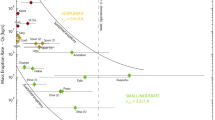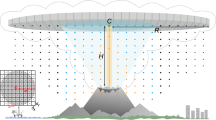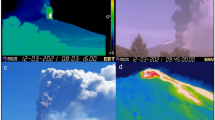Abstract
A critical factor in successfully monitoring and forecasting volcanic ash dispersion for aviation safety is the height reached by eruption clouds, which is affected by environmental factors, such as wind shear and atmospheric instability. Following earlier work using the Active Tracer High Resolution Atmospheric Model for strong Plinian eruptions, this study considered a range of eruption strengths in different atmospheres. The results suggest that relatively weak volcanic eruptions in the moist tropics can trigger deep convection that transports volcanic material to 15–20 km. For the same volcanic strength there can be ~9 km difference between eruption heights in moist tropical and dry subpolar environments (a larger height difference than previously suggested), which appears consistent with observations. These results suggest that eruption intensity should not be estimated from eruption height alone for tropospheric eruptions and also that the average height of volcanic eruptions may increase if the tropical atmospheric belt widens in a changing climate. Ash aggregation is promoted by hydrometeors (particularly liquid water), so the smaller modelled eruptions in moist atmospheres, which have a relatively small ash content for their height and water content, result in a relatively small proportion of fine ash in the dispersing cloud when compared to a dry atmosphere. This in turn makes the ash clouds much more difficult to detect using remote sensing than those in dry atmospheres. Overall, a weak eruption in the tropics is more likely to produce a plume above cruising levels for civil aviation, harder to detect and track, but with a lower concentration of fine ash than a mid-latitude or polar equivalent. There is currently no defined ‘acceptable’ concentration of ash for aircraft, but as these results suggest low-grade encounters in the tropics from undetected clouds are likely, it would be desirable to explore that issue.








Similar content being viewed by others
References
Bursik (2001) Effect of wind on the rise height of volcanic plumes. Geophys Res Lett 28(18):3621–3624
Carn SA, Krueger AJ, Bluth GJS, Schaefer SJ, Krotkov NA, Watson IM, Datta S (2003) Volcanic eruption detection by the Total Ozone Mapping Spectrometer (TOMS) instruments: a 22-year record of sulfur dioxide and ash emissions. In: Oppenheimer C, Pyle DM, Barclay J (eds) Volcanic degassing. Geological Society, London, pp 177–202
Carn SA, Krotkov NA, Yang K, Hoff RM, Prata AJ, Krueger AJ, Loughlin SC, Levelt PF (2007) Extended observations of volcanic SO2 and sulfate aerosol in the stratosphere. Atmos Chem Phys Discuss 7(1):2857–2871
Casadevall TJ, Delos Reyes PJ, Schneider DJ (1996) The 1991 Pinatubo Eruptions and Their Effects on Aircraft Operations. In: Newhall CG, Punongbayan RS (eds) Fire and Mud: eruptions and lahars of Mount Pinatubo. Philippines. Philippines Institute of Volcanology and Seismology & University of Washington Press, Quezon City & Seattle, pp 625–636
Cifelli R, Rutledge SA (1998) Vertical motion, diabatic heating, and rainfall characteristics in north Australia convective systems. Quarter J R Meteorol Soc 124(548):1133–1162
Cohen C (2000) A quantitative investigation of entrainment and detrainment in numerically simulated cumulonimbus clouds. J Atmos Sci 57:1657–1674
Dobran F, Neri A (1993) Numerical simulation of collapsing volcanic columns. J Geophy Res 98:4231–4259
Durant AJ, Shaw RA, Rose WI, Mi Y, Ernst GGJ (2008) Ice nucleation and overseeding of ice in volcanic clouds. J Geophys Res 113:D09206. doi:09210.01029/02007JD009064
Ernst GGJ, Davis J, Sparks RSJ (1994) Bifurcation of volcanic plumes in a crosswind. Bull Volcanol 56:159–169
Fierro AO, Leslie LM, Mansell ER, Straka JM (2008) Numerical simulations of the microphysics and electrification of the weakly electrified 9 February 1993 TOGA COARE squall line: comparisons with observations. Mon Weather Rev 136(1):364–379
Fromm M, Servranckx R (2003) Transport of forest fire smoke above the tropopause by supercell convection. Geophys Res Lett 30(10):1542
Fromm M, Tupper A, Rosenfeld D, Servranckx R, McRae R (2006) Violent pyro-convective storm devastates Australia’s capital and pollutes the stratosphere. Geophys Res Lett 33:L05815. doi:05810.01029/02005GL025161
Glaze LS, Baloga SM (1996) Sensitivity of buoyant plume heights to ambient atmospheric conditions: implications for volcanic eruption columns. J Geophys Res 101(D1):1529–1540
Glaze LS, Baloga SM, Wilson L (1997) Transport of atmospheric water vapor by volcanic eruption columns. J Geophys Res 102(D5):6099–6108
Graf H, Herzog M, Oberhuber JM, Textor C (1999) Effect of environmental conditions on volcanic plume rise. J Geophys Res 104(D20):24309–24320
Grindle TJ, Burcham FW (2002) Even minor volcanic ash encounters can cause major damage to aircraft. ICAO J 57(2):12–14 29
Guo S, Rose WI, Bluth GJS, Watson IM (2004a) Particles in the great Pinatubo volcanic cloud of June, 1991: the role of ice. Geochem Geophy Geosys 5(5):1525. doi:10.1029/2003GC000655
Guo S, Rose WI, Bluth GJS, Watson IM, Prata AJ (2004b) Re-evaluation of SO2 release of the climactic June 15, 1991 Pinatubo eruption using TOMS and TOVS satellite data. Geochem Geophy Geosys 5(4):Q04001. doi:04010.01029/02003GC000654
GVN (2006) Volcano activity report for soputan. In: Wunderman R, Venzke E, Mayberry G (eds) Bulletin of the global volcanism network. Smithsonian Institution, Washington DC, USA
Halmer MM, Schmincke H-U (2003) The impact of moderate-scale explosive eruptions on stratospheric gas injections. Bull volcanol 65(6):433–440
Herzog M, Graf H-F, Textor C, Oberhuber JM (1998) The effect of phase changes of water on the development of volcanic plumes. J Volcanol Geoth Res 87:55–74
Herzog M, Oberhuber JM, Graf H (2003) A prognostic turbulence scheme for the non-hydrostatic plume model ATHAM. J Atmos Sci 60:2783–2796
Holasek RE, Self S, Woods AW (1996) Satellite observations and interpretation of the 1991 Mount Pinatubo eruption plumes. J Geophys Res 101(B12):27635–27665
International Civil Aviation Organization (2009) Handbook on the international airways volcano watch (IAVW), 2nd edition Doc 9766-AN/968. ICAO http://www.icao.int/icao/en/anb/met/index.html, Montreal
Johnson RW, Casadevall TJ (1994) Aviation safety and volcanic ash clouds in the Indonesia-Australia region. In: first international symposium on volcanic ash and aviation safety. Seattle, Washington, USA, pp 191–197
Lehmiller GS, Bluestein HB, Neiman PJ, Ralph FM, Feltz WF (2001) Wind structure in a supercell thunderstorm as measured by a UHF wind profiler. Mon Weather Rev 129(8):1968–1986
Luderer G, Trentmann J, Winterrath T, Textor C, Herzog M, Graf HF, Andreae MO (2006) Modeling of biomass smoke injection into the lower stratosphere by a large forest fire (Part II): sensitivity studies. Atmos Chem Phys Discuss 6:6081–6124
Mastin LG (2007) A user-friendly one-dimensional model for wet volcanic plumes. Geochem Geophy Geosys 8(3):1525. doi:10.1029/2006GC001455
Mastin LG, Guffanti M, Servranckx R, Webley P, Barsottie S, Dean K, Durant A, Ewert JW, Nerie A, Rose WI, Schneider D, Siebert L, Stunder B, Swanson G, Tupper A, Volentik A, Waythomas CF (2009) A multidisciplinary effort to assign realistic source parameters to models of volcanic ash-cloud transport and dispersion during eruptions. J Volcano Geotherm Res in press
McClatchey RA, Fenn RW, Selby JEA, Volz FE, Garing JS (1972) Optical properties of the atmosphere 3rd edition, Air Force Cambridge Research Laboratories, Report AFCRL-72-0497. p 103
Morton BR, Taylor GI, Turner JS (1956) Gravitational turbulent convection from maintained and instantaneous sources. Proceedings of the royal society of London A234(1)
Newhall CG, Self S (1982) The volcanic explosivity index (VEI): an estimate of explosive magnitude for historical volcanism. J Geophys Res 87:1231–1238
Oberhuber JM, Herzog M, Graf H-F, Schwanke K (1998) Volcanic plume simulation on large scales. J Volcanol Geoth Res 87:29–53
Ongaro TE, Cavazzoni C, Erbacci G, Neri A, Salvetti MV (2007) A parallel multiphase flow code for the 3D simulation of explosive volcanic eruptions. Parallel Comput 33(7–8):541–560
Oppenheimer C (1998) Volcanological applications of meteorological satellites. Int J Remote Sens 19:2829–2864
Oswalt JS, Nichols W, O’Hara JF (1996) Meteorological observations of the 1991 Mount Pinatubo Eruption. In: Newhall CG, Punongbayan RS (eds) Fire and mud: eruptions and lahars of Mount Pinatubo, Philippines. Philippines Institute of Volcanology and Seismology & University of Washington Press, Quezon City & Seattle, pp 625–636
Pergola N, Tramutoli V, Marchese F, Scaffidi I, Lacava T (2004) Improving volcanic ash cloud detection by a robust satellite technique. Remote Sens Environ 90:1–22
Pieri D, Ma C, Simpson JJ, Hufford G, Grindle T, Grover C (2002) Analyses of in situ airborne volcanic ash from the February 2000 eruption of Hekla Volcano, Iceland. Geophys Res Lett 29(16):585. doi:10.1029/2001GL013688
Prata AJ (1989) Infrared radiative transfer calculations for volcanic ash clouds. Geophys Res Lett 16:1293–1296
Prata A (2008) Satellite detection of hazardous volcanic clouds and the risk to global air traffic. Nat Hazards 2:235. doi:10.1007/s11069-11008-19273-z
Prata AJ, Bluth GJS, Rose WI, Schneider DJ, Tupper A (2001) Comments on “Failures in detecting volcanic ash from a satellite-based technique”. Remote Sens Environ 78:341–346
Prata AJ, Rose WI, Self S, O'Brien DM (2003) Global, long-term sulphur dioxide measurements from TOVS data: a new tool for studying explosive volcanism and climate. In: Robock A, Oppenheimer C (eds) Volcanism and Earth's atmosphere. AGU, pp 75–92
Richards MS (2006) Volcanic Ash Cloud Heights Using the MODIS CO2-Slicing Algorithm. In: CIMSS. University of Wisconsin-Madison, Department of Atmospheric and Oceanic Sciences, Madison, p 97
Robock A (2002) Blowin’ in the wind: research priorities for climate effects of volcanic eruptions. Eos Trans AGU 83:472
Rose WI, Delene DJ, Schneider DJ, Bluth GJS, Krueger AJ, Sprod I, McKee C, Davies HL, Ernst GGJ (1995) Ice in the 1994 Rabaul eruption cloud: implications for volcano hazard and atmospheric effects. Nature 375:477–479
Sawada Y (1987) Study on analysis of volcanic eruptions based on eruption cloud image data obtained by the geostationary meteorological satellite (GMS). Meteorology Research Institute (Japan), Tokyo, p 335
Sawada Y (2002) Analysis of eruption cloud with geostationary meteorological satellite imagery (Himawari). J Geogr (Jpn) 111(3):374–394
Seidel DJ, Randel WJ (2007) Recent widening of the tropical belt: evidence from tropopause observations. J Geophys Res 112:D20113. doi:20110.21029/22007JD008861
Settle M (1978) Volcanic eruption clouds and the thermal power output of explosive eruptions. J Volcanol Geoth Res 3:309–324
Simpson JJ, Hufford G, Pieri D, Berg JS (2000) Failures in detecting volcanic ash from a satellite-based technique. Remote Sens Environ 72:191–217
Simpson JJ, Hufford G, Pieri D, Berg JS (2001) Response to comments of failures in detecting volcanic ash from a satellite-based technique. Remote Sens Environ 78:347–357
Sparks RSJ, Bursik MI, Carey SN, Gilbert JE, Glaze L, Sigurdsson H, Woods AW (1997) Volcanic plumes. Chichester, Wiley, p 589
Textor C, Graf H, Herzog M, Oberhuber JM (2003) Injection of gases into the stratosphere by explosive volcanic eruptions. J Geophys Res 108(D19):4606. doi:4610.1029/2002JD002987
Textor C, Graf H, Herzog M, Oberhuber JM, Rose WI, Ernst GGJ (2006a) Volcanic particle aggregation in explosive eruption columns part I: parameterisation of the microphysics of hydrometeors and ash. J Volcanol Geoth Res 150:359–377
Textor C, Graf H, Herzog M, Oberhuber JM, Rose WI, Ernst GGJ (2006b) Volcanic particle aggregation in explosive eruption columns part II: numerical experiments. J Volcanol Geoth Res 150:378–394
Trentmann J, Luderer G, Winterrath T, Fromm M, Servranckx R, Textor C, Herzog M, Graf H-F, Andreae MO (2006) Modeling of biomass smoke injection into the lower stratosphere by a large forest fire (part I): reference simulation. Atmos Chem Phys Discuss 6:6041–6080
Tupper A, Wunderman R (2009) Reducing discrepancies in ground and satellite observed eruption cloud heights. J Volcanol Geotherm Res (in press)
Tupper A, Carn S, Davey J, Kamada Y, Potts R, Prata F, Tokuno M (2004) An evaluation of volcanic cloud detection techniques during recent significant eruptions in the western ‘Ring of Fire’. Remote Sens Environ 91:27–46. doi:10.1016/j.rse.2004.1002.1004
Tupper A, Oswalt JS, Rosenfeld D (2005) Satellite and radar analysis of the volcanic-cumulonimbi at Mt Pinatubo, Philippines, 1991. J Geophys Res 110(D09204):746. doi:10.1029/2004JD005499
Tupper A, Itikarai I, Richards MS, Prata F, Carn S, Rosenfeld D (2007) Facing the challenges of the international airways volcano watch: the 2004/05 eruptions of Manam, Papua New Guinea. Weather Forecast 22(1):175–191
Valentine GA, Wohletz KH (1989) Numerical models of Plinean columns and pyroclastic flows. J Geophys Res 94:1867–1887
Williams ER, McNutt SR (2004) Total water contents in volcanic eruption clouds and implications for electrification and lightning. In: 2nd international conference on volcanic ash and aviation safety. Office of the federal coordinator for meteorological services and supporting research, Alexandra, Virginia, USA, pp 67–71
Wilson LS, Sparks RSJ, Huang TC, Watkins ND (1978) The control of volcanic column heights by eruption energetics and dynamics. J Geophys Res 83:1829–1836
Woods AW (1988) The fluid dynamics and thermodynamics of eruption columns. Bull Volcanol 50:169–193
Woods AW (1993) Moist convection and the injection of volcanic ash into the atmosphere. J Geophys Res 98:17627–17636
Woods AW (1995) The dynamics of explosive volcanic eruptions. Rev Geophys 33:495–530
Woods AW (1998) Observations and models of volcanic eruption columns. In: Gilbert JS, Sparks RSJ (eds) The physics of explosive volcanic eruptions. Geol Soc, London, pp 91–114
Acknowledgments
We thank Larry Mastin and one anonymous reviewer for their thoughtful reviews of an earlier draft of this paper. The first author would like to acknowledge the support of the Australian Bureau of Meteorology, and Monash University in pursuing this work, and particularly that of Geoffrey Garden and Michael Reeder. We would also like to thank Rebecca Patrick for assistance with analysis of the Soputan eruption.
Author information
Authors and Affiliations
Corresponding author
Rights and permissions
About this article
Cite this article
Tupper, A., Textor, C., Herzog, M. et al. Tall clouds from small eruptions: the sensitivity of eruption height and fine ash content to tropospheric instability. Nat Hazards 51, 375–401 (2009). https://doi.org/10.1007/s11069-009-9433-9
Received:
Accepted:
Published:
Issue Date:
DOI: https://doi.org/10.1007/s11069-009-9433-9




